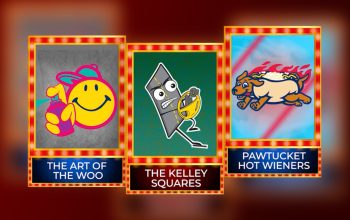The origin story of the Wisconsin Timber Rattlers’ nickname is a short one. In the succinct words of Chris Mehring, the team’s director of media relations and radio announcer, it goes like this: “A timber rattler is a snake in northern Wisconsin. It’s indigenous to the area of northern Wisconsin.”
I had surmised that perhaps the name was a double entendre that played on timber as a reference to a baseball bat—as in, their batters hit the ball so hard it makes the timber rattle. I posed the idea to Mehring, who told me, in short, no.
“It was just that’s the species of snake,” he said.
In 1995, when the Appleton Foxes moved from Goodland Field, their home since 1958, into their new stadium, now called Neuroscience Group Field at Fox Cities Stadium, the team felt the time was right to adopt a new identity. A vote by local schoolchildren selected the name Timber Rattlers over several other options, including the Fox River Current and the Fox River Phantoms (which is the only baseball logo concept I can recall seeing that incorporates a supernatural umpire).
The danger in naming a team for a snake—and putting an image of that snake front and center in your identity—is that people with snake phobias have real and visceral reactions to seeing the reptiles, or even just images of them. I wondered if the team worried that having snake imagery at every turn in their ballpark might keep some ophidiophobic baseball fans away. Again, in short, the answer was no.
“We’ve never had an Indiana Jones Night, but I don’t think that would prevent us from doing it,” Mehring said.
In fact, the serpentine identity seems to have had the opposite effect.
“For every person who is afraid of snakes, snakes, when it comes to sports brand identities in general, are normally well received,” said Dan Simon of Studio Simon, the firm responsible for the team’s rebrand after the 2010 season. “It’s something that a lot of people do like even though a lot of people are creeped out by them.”

This snake-based logo has been particularly successful. The Timber Rattlers have been on Minor League Baseball’s list of top 25 teams in terms of merchandise sales for every season but one, according to Mehring.
Keeping in mind the menacing nature of the mascot and the target audience of minor league baseball at large, the current look created by Studio Simon walks the fine line between cartoonish and intimidating.
“Inherently, minor league baseball logos are designed to not be threatening,” Simon said. “Given that minor league baseball is about, to a large degree, family entertainment first, baseball second, at least with the way these businesses are operated, the logos are meant to be a little less fierce than if they were closer representations of the actual animal and/or object.”
The team itself didn’t go into the redesign with a specific agenda regarding the tone of the new look.
“We just wanted to come up with the best logo possible,” Mehring said. “If it was going to look like a Looney Tune, if it still worked, we would have gone with that. But I think everyone is pretty happy with how it turned out.”

In today’s landscape, the Timber Rattlers name is not outlandish, but in the mid-90s, the era of wacky minor league identities was just starting to take shape.
“Fans of minor league baseball associate minor league baseball with all of the fun and weird and disparate names. We’ve got Storm Chasers and IronPigs and Lug Nuts and on and on and on, but 20 years ago, that was only just starting,” Simon said. “The Wisconsin Timber Rattlers were actually, if not in on the ground floor, they were like on the first or second floor before we reached the skyscraper heights of the crazy logos we have today.”


Of course, when the team changed from Foxes to Timber Rattlers in 1995, they didn’t just change the nickname. They changed their prefix from Appleton, the city where they continue to play, to Wisconsin. The change had an immediate effect on the range of their potential market.
“Appleton Foxes in their last year in their old stadium drew 70,000 fans,” Mehring said. “By going to the Wisconsin Timber Rattlers, the first year in the new stadium with the new logo and the regional kind of draw, drew over 200,000. The second year it was over 233,000 fans. By going from that one city to a region with a team name and a logo that went along with it, it really helped boost attendance.”
For two decades, the Timber Rattlers, a Single-A affiliate of the Brewers in the Midwest League, have quietly been one of the more successful identities in the minors. While the landscape has heaved and changed around them, the Timber Rattlers have stealthily held their ground, staying atop the charts as one of baseball’s most steadfast brands.















